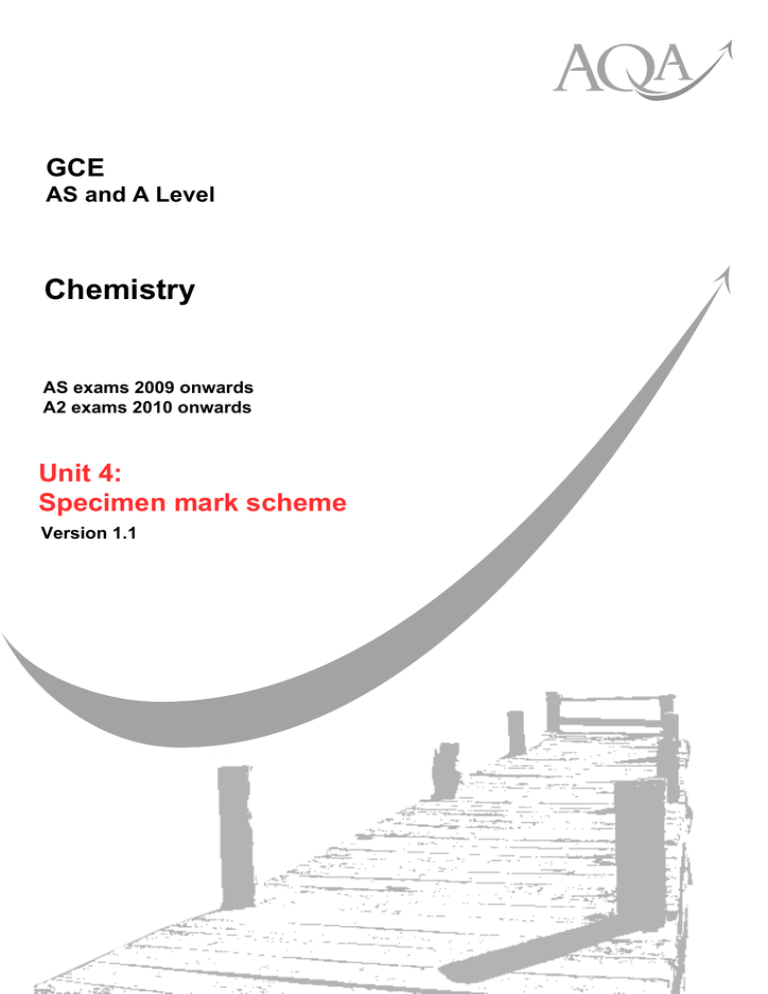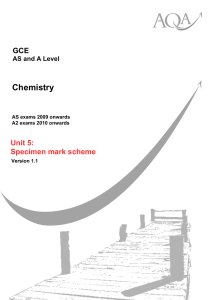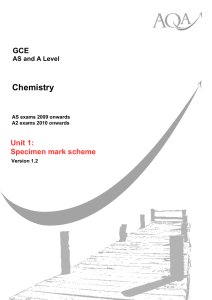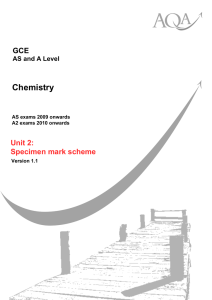GCE A Level Chemistry Unit 4 Mark Scheme
advertisement

GCE AS and A Level Chemistry AS exams 2009 onwards A2 exams 2010 onwards Unit 4: Specimen mark scheme Version 1.1 Version 1.1: 07/07 abc General Certificate of Education Chemistry 2420 CHEM4 Kinetics, Equilibria and Organic Chemistry Mark Scheme Specimen Paper Mark schemes are prepared by the Principal Examiner and considered, together with the relevant questions, by a panel of subject teachers. The specimen assessment materials are provided to give centres a reasonable idea of the general shape and character of the planned question papers and mark schemes in advance of the first operational exams. It must be stressed that a mark scheme is a working document, in many cases further developed and expanded on the basis of candidates’ reactions to a particular paper. Assumptions about future mark schemes on the basis of one year’s document should be avoided; whilst the guiding principles of assessment remain constant, details will change, depending on the content of a particular examination paper. Copyright © 2007 AQA and its licensors. All rights reserved. COPYRIGHT AQA retains the copyright on all its publications. However, registered centres for AQA are permitted to copy material from this booklet for their own internal use, with the following important exception: AQA cannot give permission to centres to photocopy any material that is acknowledged to a third party even for internal use within the centre. Set and published by the Assessment and Qualifications Alliance. The Assessment and Qualifications Alliance (AQA) is a company limited by guarantee registered in England and Wales (company number 3644723) and a registered charity (registered charity number 1073334). Registered address: AQA, Devas Street, Manchester M15 6EX Dr Michael Cresswell Director General GCE CHEMISTRY UNIT 4 SPECIMEN MARK SCHEME / VERSION 1.1 Question 1 (a) (b) (i) 2 (1) (ii) 0 (1) (i) rate/[NO2]2[O2] 13 mol dm-3 (1) (1) (1) (ii) 1.9 × 10-3 (1) (iii) Step 2 (1) Question 2 (a) (i) (ii) (iii) C + 3D 2A + B mol dm-3 (forward reaction is) exothermic or more products formed (1) (1) (1) (b) (i) Moles of iodine = 0.023 Moles of HI = 0.172 [ H 2 ][ I 2 ] Kc = [ HI]2 V cancels in Kc expression (1) (1) (1) (ii) (iii) (iv) (v) Kc = (1) (0.023) 2 (0.172) 2 = 0.0179 or 1.79 × 10-2 Kc = 55.9 or 56 Conseq i.e. (answer to (iv))–1 (1) (1) (1) Question 3 (a) (i) (ii) (b) (1) (1) (1) (1) (1) B C A cresolphthalein or thymolphthalein + pH = -log[H ] = Ka [H + ] 2 [CH 3 COOH] + - or [H ] = [A ] + [H ] = √ 1.74 × 10-5 × 0.15 (or 1.62 × 10-3) pH = 2.79 (penalise 1 dp or more than 2dp once in the qu) Question 4 3 (1) (1) (1) GCE CHEMISTRY UNIT 4 SPECIMEN MARK SCHEME / VERSION 1.1 (a) (i) (ii) addition of small amounts of acid send eqm to left or extra H+ removed by reaction with HCO3ratio [H2CO3]/[ HCO3-] remains constant hence [H+] and pH remain const (1) pH = 7.41 ∴ [H+] = 3.89 ×10-8 mol dm-3 (1) + Ka = = ][HCO 3− ] [H [H 2 CO 3 ] (1) (3.89 × 10 -8 )(2.5 × 10 -2 ) 1.25 × 10 (1) = 7.78 ×10-8 mol dm-3 -2 (1) allow error carried forward mark. Do not penalise twice. moles H+ added = 10 × 10-3 × 1.0 (b) (ii) moles ethanoic acid after addition = 0.01 = 0.15 + 0.01 = 0.16 moles ethanoate ions after addition = 0.10 - 0.01 = 0.09 K a [CH 3 COOH] [H+] = (1) (1) [CH 3 COO − ] = 1.74 × 10-5 × (1) (1) (1) 0.16 / V 0.09 / V (1) pH = 4.51 Question 5 (a) (i) CH(CH 3)2 H2 N C C H O O (1) (ii) CH(CH3)2 H2N CH(CH3)2 C C N C H O H H COOH (1) (iii) hydrogen bonding (do not allow H-bonding) QWC (1) do not penalise any error twice. (b) (i) CH3 H C C (1) CH3 CH3 4 GCE CHEMISTRY UNIT 4 SPECIMEN MARK SCHEME / VERSION 1.1 (ii) H H3C C CH2CH3 H (iii) (1) C Isomer must be saturated or must not contain a double bond (1) (c) (d) (i) (ii) C (CH2)2 C N (CH2)6 N O H O (2) H heat/reflux with aqu NaOH (1) poly(alkene) is inert/ no reaction (1) polyamide is hydrolysed (or undergoes hydrolysis) to form acid salt and alcohol e.g combustion heat energy produced toxic gases produced (1) QWC (1) (1) (1) Question 6 (a) GLC or distillation (1) (b) C=O (1) Cl has two isotopes (1) (c) (i) (ii) CH3C O . C4H7ClO+ → CH3C O + (d) (e) (f) (g) . C2H4Cl (1) (1) (i) e.g. CDCl3 or CCl4 (1) (ii) Si(CH3)4 (1) 0 and 3 (1) CH3 C CH CH3 O Cl (1) CH3CH2CH2COCl or (CH3)2CHCOCl 5 (1) GCE CHEMISTRY UNIT 4 SPECIMEN MARK SCHEME / VERSION 1.1 Question 7 (a) (i) (ii) There are three pairs of equivalent carbon atoms 75ppm (1) (1) (b) (i) (ii) 4 2 Each structure can represent a pair of cis/Z and trans/E isomers OR Optical isomers (1) (1) (1) (c) Question 8 Mark Range The marking scheme for this part of the question includes an overall assessment for the Quality of Written Communication (QWC). There are no discrete marks for the assessment of QWC but the candidates’ QWC in this answer will be one of the criteria used to assign a level and award the marks for this part of the question Descriptor an answer will be expected to meet most of the criteria in the level descriptor 4-5 - claims supported by an appropriate range of evidence - good use of information or ideas about chemistry, going beyond those given in - the question argument well structured with minimal repetition or irrelevant points 2-3 accurate and clear expression of ideas with only minor errors of grammar, punctuation and spelling - claims partially supported by evidence - good use of information or ideas about chemistry given in the question but - limited beyond this the argument shows some attempt at structure 0-1 the ideas are expressed with reasonable clarity but with a few errors of grammar, punctuation and spelling - valid points but not clearly linked to an argument structure - limited use of information or ideas about chemistry - unstructured - errors in spelling, punctuation and grammar or lack of fluency (a) (i) Mr of CH3COCl = 78.5 Mr of C6H5NH2 = 93 total Mr of reagents = 264.5 % atom economy = M r of wanted product × 100 total M r of all reagents 6 (1) QWC (1) GCE CHEMISTRY UNIT 4 SPECIMEN MARK SCHEME / VERSION 0.2 135 × 100 = 51.0 % 264.5 = (ii) expected yield = (1) 10 × 0.5 × 135 = 7.26 kg 93 (1) 5.38 × 100 = 74.1 % 7.26 % yield = (1) (iii) Although yield appears satisfactory (74%) % atom economy is only 51% nearly half of the material produced is waste and must be disposed of (b) QWC QWC (nucleophilic) addition-elimination M2 H3C O (1) O C Cl M1 C6H5 (1) (1) H3C C C6H5 N NH2 Cl H M3 for structure M4 for 3 arrows and lone pair O → CH3 C NHC6H5 H QWC (2) (4) (c) HNO3 + 2H2SO4 → NO2+ + H3O+ + 2HSO4- (1) M2 structure (3) M1 M3 arrow NO2 H NO2 Question 9 H CH3CN or ethanenitrile (1) S Step 1 CH3CH2NH2 or ethylamine KCN aq/alcoholic H2 Ni secondary amine (1) (1) (1) (1) (1) (1) Step 2 W CH3 CH3CH2 N CH3 (Br-) CH3 7 (1) GCE CHEMISTRY UNIT 4 SPECIMEN MARK SCHEME / VERSION 1.1 nucleophilic substitution (1) Question 10 Acidified potassium dichromate(VI) Turns green with propan-2-ol and propanal No reaction with hexene and 1-bromopropane Tollens with propan-2-ol and propanal only propanal gives silver mirror Bromine water Decolourised by hexene No reaction with 1-bromopropane Warm NaOH followed by acidified AgNO3 White ppt with 1-bromopropane 8 (1) (1) (1) (1) (1) (1) (1) (1) (1) (1)






